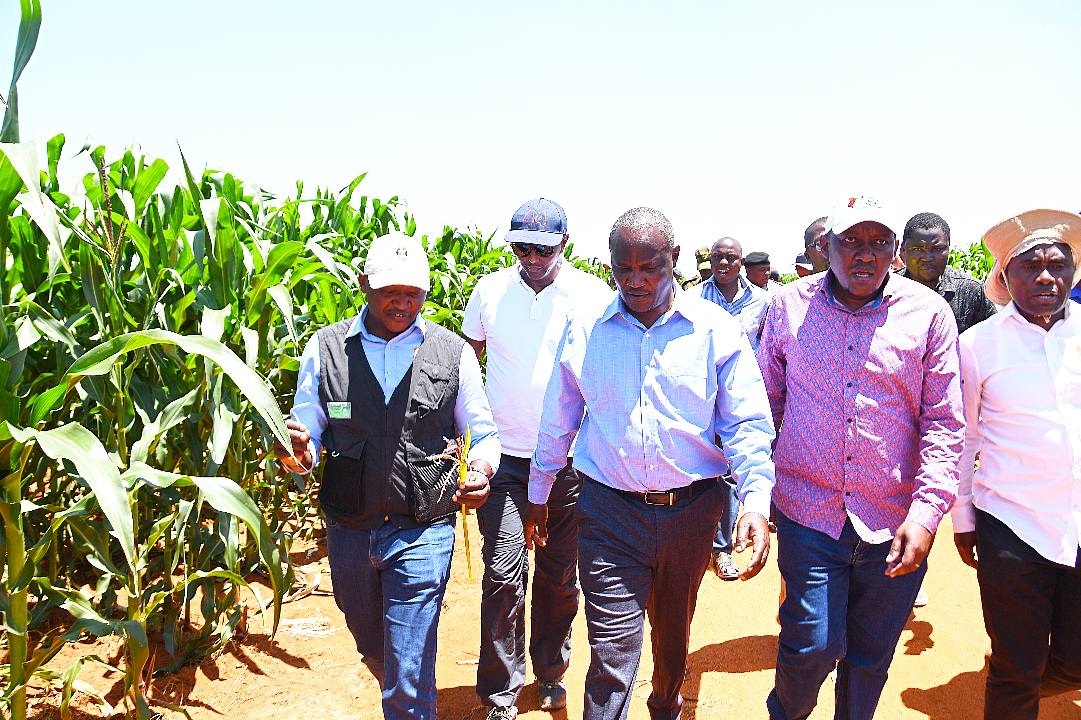
Irrigation secretary Joel Tanui, Treasury CS John
Mbadi and Irrigation PS Ephantus Kimotho at Galana Kulalu on Wednesday / BRIAN
OTIENO
The government has placed irrigation at the heart of Kenya’s food security and economic growth strategy, Treasury Cabinet Secretary John Mbadi has said.
He spoke during an inspection tour of the Sh500 million Galana Kulalu Food Security Project, which is being implemented in three phases.
Phase One, targeting 10,000 acres, has already seen 1,500 acres of maize under cultivation by Selu Africa Limited, with the first harvest expected next week. By the end of this month, another 1,700 acres will be under maize, rising to 6,400 acres by June next year and eventually 10,000 acres.
“Galana Kulalu is steadily positioning
itself as Kenya’s future breadbasket,” Mbadi said.
Phase Two, which targets 200,000 acres, will require the construction of the Galana Kulalu Dam. “Agreements on financing have been finalizsed and groundbreaking will happen soon,” the CS said, adding that the government expects the second phase to be operational by 2027.
Kenya currently faces a maize
deficit of 10 to 15 million bags annually. Mbadi said putting 200,000
acres under irrigation could generate up to 14 million bags a year, eliminating
the need for imports.
“This will not only secure food but also save foreign exchange, stabilise the shilling, spur economic growt, and create jobs,” he said.
The government is also expanding other irrigation schemes: 50,000 acres each for rice and sugarcane at Bura, while West Kano, Ahero, Oluch Kimira and Lower Kuja are earmarked for rice. Investments totaling Sh6.8 billion will support rice production, targeting a sharp reduction in imports, currently more than 700,000 tonnes annually.
Lower Kuja will see 10,000 acres put
under rice with Sh500 million annually over four years, while Oluch Kimira will
receive Sh100 million to cover 2,000 acres. Mwea Irrigation Scheme is also set
for expansion.
Beyond food staples, Mbadi said the government is reviving cotton to boost the textile industry, saying fertile lands in Western and Coast regions could anchor raw material supply for apparel manufacturing.
“Irrigation is not just about food security, but also about unlocking agro-industries. That’s what Gen Zs need—jobs and innovation,” the CS said.
Irrigation PS Ephantus Kimotho highlighted the economic returns, saying 10,000 acres at Galana alone could generate Sh2.8 billion annually and 500 direct jobs. At full mechanised capacity, the project is expected to employ 5,000 people.
“Irrigation is also a pillar of
climate resilience, guaranteeing year-round production,” he said. “Through County Aggregated Irrigation Plans, large-scale and smallholder
producers will work together to tackle deficits like rice.”
For the government, irrigation is not just an agricultural tool but the backbone of food security, job creation and a resilient economy.
Instant Analysis:
The Galana Kulalu project is more than an irrigation scheme—it’s a test of whether Kenya can finally shake off chronic food deficits. For decades, the country has imported maize and rice to plug shortages, draining foreign exchange and exposing households to price shocks. Treasury CS John Mbadi’s inspection tour signals the government’s intent to move from rhetoric to results. If the ambitious targets are met—200,000 acres producing 14 million maize bags annually and expanded rice schemes—Kenya could cut imports drastically. But success hinges on timely investment, strong management, and shielding projects from the corruption that has doomed past efforts.












